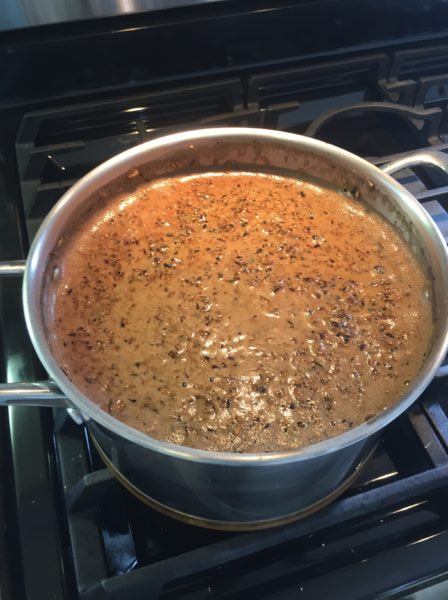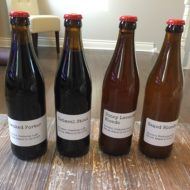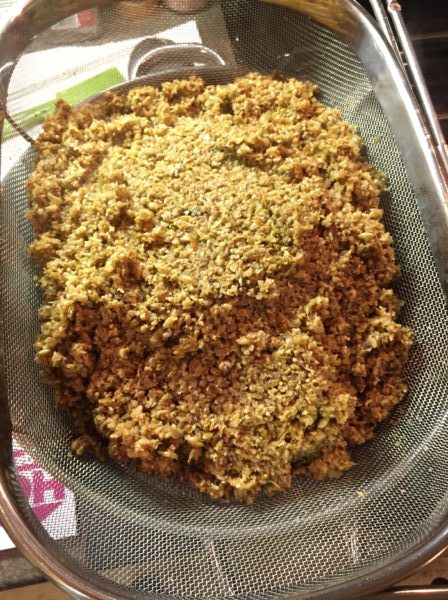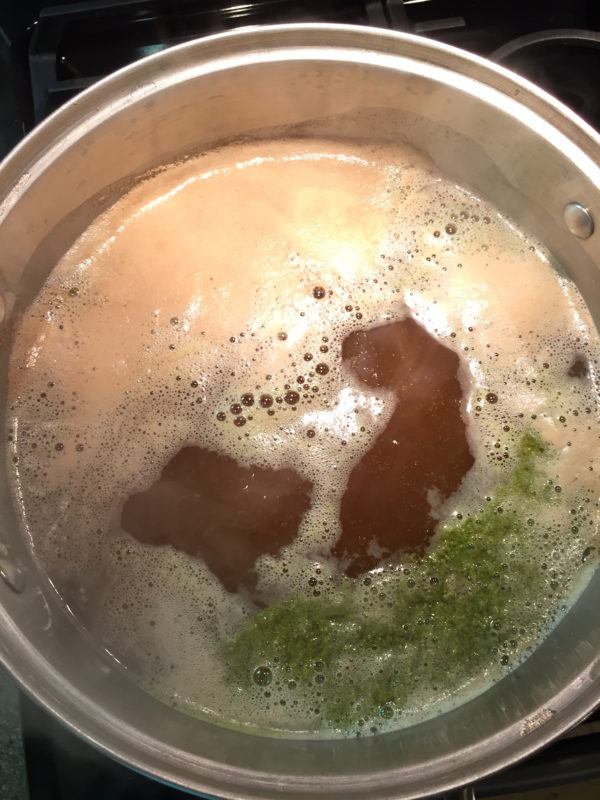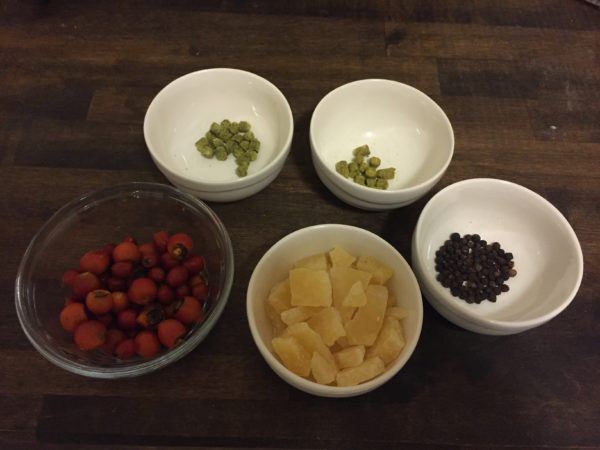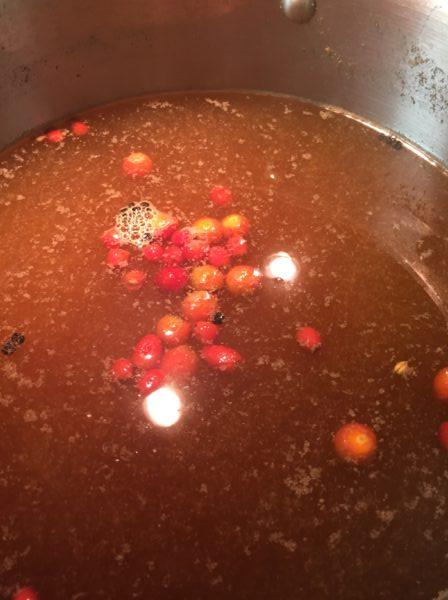So I chickened out. This post was supposed to be about a cayenne pepper, dark chocolate, stout. The plan was mimic the flavours found in a traditional mole, but in beer form. Fail. First I couldn’t find cocoa nibs in any of the fancy grocery stores. I considered ordering online, but apparently I’m too lazy to shop from my couch now and by the time I found motivation it was too late for this particular batch. I did brew with loads of chocolate malt, but there was some fear of adding hot pepper to beer on it’s own. For the record I had a really cool plan of making a tincture out of cayenne pepper, cocoa nibs, and organic vodka and then adding it after fermentation. There, so do I get some credit for being creative? No? Fair enough.
Disclaimer, I don’t like stout. I struggle to make it through a Guinness and that’s with a face worthy of a Buckley’s commercial. Brian loves stouts. He visited the Guinness plant and still talks about it every time we go to an Irish pub. So this beer is for him, because I love him or something.
Nothing really fancy about this recipe. It is my first time working with flaked oats. Oats are one of the reasons why stouts are so heavy. People say drinking a Guinness is like drinking a meal; well that meal is breakfast and oatmeal is on the menu. Oats are also supposed to contribute to the silky mouth-feel of a good stout. They also help make for a creamier head (Beavis and Butthead laugh). Confession: I didn’t actually know what to do with the oats to make all of these fancy things happen. I could have looked it up, but my mash water was already to temperature so I tossed them in my trusty Victoria Grain Mill and ground them with the rest of the mash. Sounds about right?
Print Recipe
Oatmeal Stout
Instructions
Mash
-
-
Steep for 60 minutes at 152 F
Hot break at 170 F after 60 minutes
Sparge
-
Filter water through mash
Boil
-
0 minutes add 3/4 of the Fuggle hops
45 minutes add 1/4 of the Fuggle hops
Recipe Notes
Cold Break
Instead of ice, I cool my brew pot by dunking it in a sink full of cold water and ice packs from my mom (who is paranoid about food safety and travelling with food) and the local sports injury clinic.
Fermentation
After the beer has cooled, add filtered beer plus 1/2 packet of yeast to carboy and shake vigorously.
Sadly this looks like it’s going to be a relatively low alcohol beer. The specific gravity at 21 C is only 1.048, which should yield an alcohol content in the mid to high 4%. Not terrible, but I never say no to more alcohol. Wait that sounds bad. So back to the hydrometer…it’s science…science is smart and reputable…ok better.

The second beer in the epic garden series of two. I really think this purple flowery thing is lavender. It smells like an old lady’s closet and it sort of tastes like soap (yes I ate some, a sin for any chemist). Next obvious step is to add it to a beer and see what happens! I opted to go with a more traditional Belgian Blonde recipe rather than continue my recent penchant for brewing with Simpsons Golden Naked Oats (see posts on naked smoked porter and very naked rosehip blonde ale). Don’t worry, I found a new “it” grain to overuse. After much debate on how to effectively balance the lavender flavour, I stumbled upon honey malt. According to Google everyone should use it and it adds a more professional complexity to your home brews. Challenge accepted (ie. I know I will screw this up somehow).
I did debate adding citrus rather than going with a sweeter flavour profile. I “think” lemon zest at flameout or maybe after fermentation might enhance the lavender without making the beer taste like those faintly candy shaped, 90’s, decorative soaps that every family had in a fancy basket in the bathroom (and NOW we worry about kids eating laundry detergent pods, seriously). Oh well, the lavender plant is fairly large so plenty left over to experiment with later (lavender plants get big and bushy right? Right…?).
Now the fun bit: crank up the alcohol content! I’m using leftover supposed-to-be-clear-but-my-cats-were-being-cute-so-now-it’s-amber Belgian style candi sugar from the rosehip blonde ale. I plan to write a post on how to make your own inverted candi sugar without special gadgets next week. It might happen. I also decided to squirt a liberal amount of honey out of a small bear’s head to hopefully boost the honey malt flavour.
Print Recipe
Honey Lavender Blonde Ale
Instructions
Mash
-
-
Steep for 60 minutes at 144-152 F
Hot break at 170 F after 60 minutes
Sparge
-
Filter water through mash
Boil
-
0 minutes add 4/5 of the East Kent Golding hops
55 minutes add 1/5 East Kent Golding hops
At flame-out add honey and dissolve
Recipe Notes
Cold Break
Instead of ice, I cool my brew pot by dunking it in a sink full of cold water and ice packs from my mom (who is paranoid about food safety and travelling with food) and the local sports injury clinic.
Fermentation
After the beer has cooled, add filtered beer plus 1/2 packet of yeast to carboy and shake vigorously.
Add pasteurized lavender on day 5. Lavender must be pasteurized to eliminate bacteria and wild yeast (it was from outside! a scary place full of scary things, like random yeast floaties). I achieved this by soaking the dried lavender in boiling water (just enough to cover) and covering with sanitized plastic wrap. I allowed the mixture to cool before adding to the carboy.

There is much debate about how to add lavender without releasing funky tasting oils, or infecting your brew with bacteria or wild yeast (worst stripper name ever?). I decided to allow the beer to ferment for about a week and then made a tea out of a tablespoon of dried lavender and a quarter cup of hot water. In theory, the lavender won’t boil and release oils, and the scalding hot water will kill any nasties. Maybe it worked?
I was inspired by Brooklyn Brew Shop, who developed recipes for a few spring beers using items normally found in a garden, to make my own beer using materials I’ve harvested from my own garden. Miraculously, my house came with a beautiful garden containing (presumably) lavender and rose bushes, among many other plants (at least I hope so, I don’t want to poison anyone, pinky swear). So this fall I harvested some rosehips and some lavender, with only slightly confused and incredulous comments from my neighbour. So glad I’ve managed to avoid killing this thing for four years. So with much further ado, and many random musings, I will present to you: the garden series!
A Belgian style, particularly a Blonde Ale, is ideal to showcase delicate flavours: very clean, not overly hoppy, and very little aftertaste. So why is this batch “very naked”? I started reading about Simpsons Golden Naked Oats and got a little overzealous. It was definitely a case of knowing just enough to get myself into trouble. I read a lot about how this particular product can improve a beer and totally missed that you should only use between 4-15%. So here comes clumsy old me like a bull in a china shop and I make a recipe with 20% golden naked oats. The whole subtle and delicate thing? Maybe it will work out. I hope. Probably not. Oops.
The other interesting and potentially tragic part of this brew: I used leftover Clear Candi sugar from Nail Polish Remover Tripel. Unfortunately I don’t have a candy thermometer, I’m too cheap to buy one, and I refuse to pay for fancy imported sugar, so I tried making my own Belgian Candi sugar without tracking temperature. This was a first attempt and it is anything but clear. I didn’t keep the sugar at the hard crack stage long enough while boiling, poured it out to harden, and came back to a gooey mass of sweet sweet can…dy. Fail. I scraped everything off of the parchment paper, threw it back in the pot, and boiled it for another 5 minutes at high heat. The result was a very hard, but decidedly not clear, candi sugar. Close enough? I will go over my now perfected, totally non-scientific, fancy-pants method of making candi sugar without a candy thermometer in another post.
Print Recipe
Rosehip Blonde Ale
Instructions
Mash
-
-
Steep for 60 minutes at 150 F
Hot break at 170 F after 60 minutes
Sparge
-
Filter water through mash
Boil
-
0 minutes add 1/3 of the Hallertau hops
30 minutes add 1/3 Hallertau hops and 1/4 Saaz hops
45 minutes add 1/3 Hallertau hops and 1/4 Saaz hops
55 minutes add 1/2 Saaz hops
At flame-out add pepper, rosehips, and candi sugar
Allow to steep for 30 minutes
Recipe Notes
Cold Break
Instead of ice, I cool my brew pot by dunking it in a sink full of cold water and ice packs from my mom (who is paranoid about food safety and travelling with food) and the local sports injury clinic.
Fermentation
After the beer has cooled, add filtered beer plus 1/2 packet of yeast to carboy and shake vigorously
The specific gravity, determined by hydrometer, is 5.0. This corresponds to an estimated alcohol content of 6.4%. I will update with final alcohol content and tasting notes in around 2 weeks.

Cheers!
So the first real recipe vomited from my brain (and Google) is a smoked porter. The naked part comes in because it uses Simpsons Golden Naked Oats (I wasn’t naked for THIS batch, or any batch, because sanitation and windows and won’t somebody think of the children. Gasp. Faint).
My sister gifted me with a box of brewing goodies for Christmas, including smoked malt, midnight wheat, and golden naked oats. Until this point I had never heard of golden naked oats, but the guy at the brew shop assured her they were excellent and what most home brewers are missing in their brews. Supposedly they provide better head retention and a fruity finish. Cool. These grains were all un-milled so prior to brew day I found a local-ish brew shop and purchased a Victoria Grain Mill (will review shortly). Look, milled grains!!!

This is my first real dark beer, so there is a bit of fear surrounding bitterness and drinkability. I have no idea how to actually balance these types of flavours, and to make it all a little more sideways; I don’t even drink Porter. This is a Brian beer. He is a fan of anything dark and recently found an excellent, but fairly expensive, wine barrel aged porter. The plan, in theory/ hopefully/ on my knees begging for divine intervention, is to create a similar smokey/fruity flavour profile using the smoked malt and golden naked oats. I also read that midnight wheat is a safer way of getting that earthy porter taste without venturing into the realm of bitter, dark, and unpalatable (I might be talking about my soul here).
So the recipe:
Print Recipe
Smoked Porter
Instructions
Mash
-
-
Steep for 60 minutes at 150 F
Hot break at 170 F after 60 minutes
Sparge
-
Filter water through mash (for those who aren’t familiar with all-grain brewing, the mash and accompanying liquid is placed in a strainer over a pot. The water is then poured over the strained mash. Then you stick the strainer over another pot and pour all of that liquid over the mash. To avoid mess I sometimes use a ladle to evenly distribute the liquid over the mash pile)
Boil
-
50% hops at beginning of boil, 50% at 45 minute mark
Recipe Notes
Cold break
Instead of ice, I cool my brew pot by dunking it in a sink full of cold water and ice packs from my mom (who is paranoid about food safety and travelling with food) and the local sports injury clinic.
Fermentation
After the beer has cooled add filtered beer plus 1/2 packet of yeast to carboy and shake vigorously.
Using my handy hydrometer, I determined that the specific gravity of this batch is 4.4. In theory, the final product will have an alcohol content around 5.4%. Generally, the alcohol level is slightly lower because not all of the sugar is converted to alcohol.
The beer has been deposited in the fermentation room (cough cough bathroom) and it should be ready for bottling in 2 week. I plan to cold-crash it for a day or two before bottling to help with clarity. This means I stick it in the fridge for a day or two so that the yeast cake at the bottom of the carboy firms up a bit (just like testing total suspended solids in sewage samples. Tasty).

Will update you with tasting notes!

